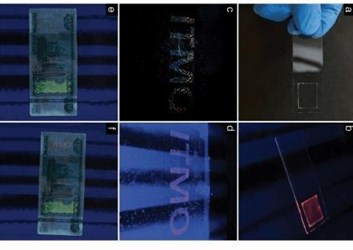Nanoparticle Ink Lets Regular Inkjet Printers Produce Glowing Holograms

Researchers at ITMO University have unveiled a new approach to printing luminescent structures based on nanoparticle ink. The unique optical properties of the ink were achieved by means of europium-doped zirconia. Particles of this material were proven to be useful in manufacturing glowing holographic coatings with a high degree of protection. Notably, the developed approach enables the fabrication of custom holograms by means of a simple inkjet printer. The results of the research were published in RSC Nanoscale.
The idea of Inkjet printing using functional nanoparticles has been gaining a lot of traction in recent years. Due to a number of advantages – lack of toxicity, high refraction index and high quantum yield – luminescent nanoparticles are finding more applications in the fields of photonics, theranostics and bioimaging; they are used to produce biosensors, visualize cancer cells and in security printing technology. But to implement lab-made solutions on a bigger scale, a number of steps need to be taken to ensure proper functionality and stability during long-term storage of holograms.
The new ink developed by the scientists from ITMO University possesses characteristics that address precisely these issues. In a series of experiments the material was used for printing monolayers of luminescent-protected holograms and anti-counterfeiting objects with high stability and durability.
This is far from the first research into inkjet printing of luminescent optical nanostructures that has been done at ITMO University. The study builds on previous work conducted as part of a bigger project funded by the Russian Science Foundation. Earlier, the scientists developed the world’s first method of printing holographic images using an inkjet printer. Back then, the team used ink based on titanium dioxide.
One of the most promising applications for the new ink is in the field of security printing – such as polygraphic manufacture of bills, bonds and documents. Unlike the existing technologies, the new method makes it possible to create varied individual holograms on industrial scale – for instance, a specific pattern or a number sequence on a document that requires protection.
Source: ITMO University
